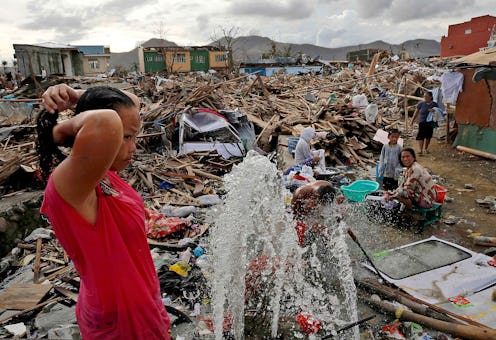News
What We Forget About The Philippines
Disaster relief continues in the Philippines after typhoon Haiyan tore through the country last week. Almost 10 million people were affected by the storm, which left thousands dead. Now, as survivors are exhausting existing food and water supplies, emergency crews fear disease outbreaks and water shortages. The bodies of the dead, meanwhile, lie in the streets and in rubble, as aid organizations assure survivors that the dead do not pose a public health risk.
"We had cases of severely dehydrated children from dysentery," Francis Visto, a doctor, told NBC news. Relief organizations are working on installing 20,000 gallon tanks of water to disincentive the looting of individual bottles, and to make it unnecessary for people to boil their own water. Meanwhile, the World Health Organization advises people on the treatment of the deceased:
The widespread belief that corpses pose a risk of communicable disease is wrong. Especially if death resulted from trauma, bodies are quite unlikely to cause outbreaks of diseases such as typhoid fever, cholera, or plague, though they may transmit gastroenteritis or food poisoning syndrome to survivors if they contaminate streams, wells, or other water sources. [...]Relief workers should respect the wishes of the families and communities of the dead to observe whatever cultural and religious events are usually practiced on death. This is important in helping people deal with the psychological impact of such disasters. Encouraging stricken communities to carry out traditional ceremonies and grieving processes sets in motion the process of disaster recovery.
Earlier this week, the United States sent an aircraft carrier, the USS George Washington, to the Philippines alongside other navy ships. The George Washington comes equipped with 5,000 sailors and 80 aircraft, and is just one part of our aid package to the typhoon-ravaged country: we’re also providing $20 million for their own aid efforts, though it’s still not the largest sum we have provided in comparable disasters. (In contrast, China — the world’s second-largest economy — has sent $100,000, and another $100,000 through the Red Cross.) But our friendly relations with the Philippines are a fairly new phenomenon.
Even in the pretty ambiguous field of disaster relief (ambiguous in the sense of who should handle it, not whether it should be provided), the U.S. has a vested interest in the island nation, along with a long history.
As you might recall, the United States seized the Philippines during the Spanish-American war, in the midst of a broader attempt to expand its power into the Atlantic and Pacific oceans. At that time, the country had already spent three centuries as a Spanish colony As PRI puts it:
That didn't go down too well, and led quickly to a nationalist rebellion and a prolonged insurgency. Thousands of Americans served there in operations recognizable to those who served in Iraq — with combat outposts, patrolling and training of local forces.
The United States crushed the rebellion, but proceeded to expand the right to self-government in the Philippines in the coming decades. By World War II, Americans and Filipinos fought alongside one another, and the country gained independence in 1946. But still, the U.S. held on to its Philippine bases, which became “small American towns, with schools, movie theaters, ball parks, and more.”
The Philippines finally kicked the U.S. out in 1991, in the midst of a natural disaster. Instead, American forces moved to Guam and other Pacific countries. But the terrorist attacks of Sept. 11 brought the two countries closer once more, when they united in a common fight against Islamic extremism. (The Philippines also faces an al Qaeda-related threat in its southern regions.) So now, they’re perhaps more allies than unequal partners, but the U.S. still has a lot riding on maintaining a good relationship with the nation, and helping it rebuild.
